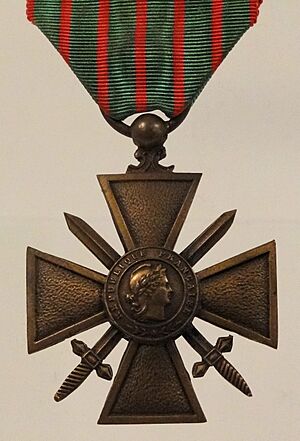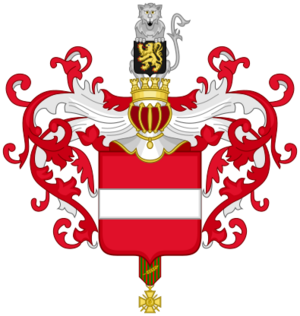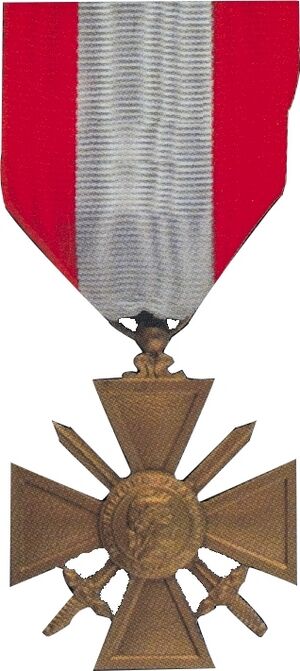Croix de Guerre facts for kids
Quick facts for kids Croix de Guerre |
|
|---|---|
 |
|
| Type |
|
| Eligibility | Military personnel only, often bestowed to members of allied countries |
| Awarded for | Individuals who distinguish themselves by acts of heroism involving combat with enemy forces |
| Campaign(s) |
|
| Status | Active |
| Description | A bronze cross with swords |
| Clasps | None for wars or campaigns; stars and palm denote level of each medal awarded |
| Statistics | |
| Established | April 2, 1915 |
|
|
The Croix de Guerre (which means Cross of War in French) is a special military decoration from France. It was first created in 1915. The medal looks like a square cross with two crossed swords. It hangs from a colorful ribbon.
This award was first given out during World War I. It was also awarded again in World War II and in other conflicts. For wars fought outside France, a special version called the croix de guerre des théâtres d'opérations extérieures was created in 1921. The Croix de Guerre was often given to soldiers from other countries who were allies of France.
The Croix de Guerre can be given to individual soldiers. It is also awarded to entire military units. It is for those who show great bravery in fighting the enemy. Soldiers receive it when their heroic actions are "mentioned in dispatches". This means their brave deeds are officially recognized by their military leaders. When a unit gets the Croix de Guerre with a palm, it means its members performed many heroic acts together.
Contents
What the Medal Looks Like
The Croix de Guerre medal can look a little different. This depends on which country gives the award. It also depends on which war it was given for. For example, France has separate medals for World War I and World War II.
When a military unit receives the Croix de Guerre, they also get a fourragère. This is a braided cord. Soldiers wear it on the shoulder of their uniform.
Sometimes, a soldier might receive the Croix de Guerre more than once. This could be for different brave actions. Or it could be from different sources. Soldiers were allowed to wear all the Croix de Guerre medals they earned. To tell them apart, their records would say things like French Croix de Guerre (WWI).
French Croix de Guerre Medals
There are three main types of Croix de Guerre medals in France:
- 106px Croix de guerre 1914–1918 (for brave actions in World War I)
- 106px Croix de Guerre 1939–1945 (for brave actions in World War II)
- 106px Croix de guerre des théâtres d'opérations extérieures (TOE) (for wars fought outside France, not World War I or II)
The Croix de Guerre was created by a law on April 2, 1915. This idea came from a French leader named Émile Briant. Before this, heroic actions were only written down. There was no medal. A sculptor named Paul-André Bartholomé designed the medal. It is a bronze cross with swords. It shows the face of the French Republic.
The French Croix de Guerre shows that a soldier was "mentioned in dispatches." This means a commanding officer, like a regimental commander, officially recognized their bravery. The ribbon of the Croix has special pins. These pins show how high up the officer was who gave the mention:
- A bronze star means the soldier was mentioned by a regiment or brigade leader.
- A silver star means the soldier was mentioned by a division leader.
- A gold star means the soldier was mentioned by an army corps leader.
- A bronze palm means the soldier was mentioned by an army leader.
- A silver palm means the soldier earned five bronze palms.
- A gold palm was for mentions by the Free French Forces (only in World War II).
The French Croix de guerre des TOE was made in 1921. It was for wars fought in other countries. It was given during the Indochina War, the Korean War, and other conflicts. This is the only version of the Croix de Guerre that is still active today. However, it has not been given out since the Kosovo War in 1999.
When World War II started in 1939, a new Croix de Guerre was created. Later, during the war, there were some changes to this award by different French governments. But in 1944, General Charles de Gaulle brought back the 1939 Croix.
The Croix de Guerre is a very important French award. It ranks between the Ordre national du Mérite and the Croix de la Valeur Militaire. The World War I Croix is considered more senior than the World War II one. And the World War II one is more senior than the TOE Croix.
Unit Awards

The Croix de Guerre can also be given to military units. This shows that the whole unit performed brave actions together. When a unit gets this award, it is shown on their flag. A unit, like a regiment or a battalion, is always mentioned at the army level. So, the Croix they receive is a Croix de Guerre with a palm. Other groups, like cities or companies, can also receive the Croix.
If a unit is mentioned twice for bravery, it receives the fourragère of the Croix de Guerre. All soldiers in that unit wear this fourragère. If a soldier was part of the unit when it earned the award, they can wear the fourragère for the rest of their military service.
Soldiers who joined the unit after the brave actions happened could wear the fourragère only while they were part of that unit. They would take it off if they transferred to another unit. This rule only applied to the French version of the Croix de Guerre.
Many units from other countries also received this award. For example, the 2nd Battalion Devonshire Regiment of the British Army received the French Croix de Guerre with palm. This was for their brave defense of Bois des Buttes in 1918. Several other British Army battalions also received the award.
United States Soldiers and Units Honored
Many American soldiers and units have been honored with the Croix de Guerre.
During World War I, the 104th Infantry Regiment of the 26th "Yankee" Division showed great bravery in April 1918. They fought off German attacks near Apremont, France. French General Fenelon F.G. Passaga decorated their regimental flag with the Croix de Guerre. This made the 104th Infantry the first American unit to be honored by a foreign country for bravery. Also, 117 members of the 104th Infantry received the award, including their commander, Colonel George H. Shelton.
In World War II, the 320th Bombardment Group received the Croix de Guerre avec Palme. This was for their actions in Italy in 1944. They were the first American unit in that war to get this award. Members of the 440th AAA AW Battalion also received the Croix de Guerre avec Palme. This was for stopping a German attack in Belgium during the Battle of the Bulge in December 1944.
On June 21, 1945, French General De Gaulle honored the 34th United States Infantry Division. He called them an "elite division" for their brave help in Tunisia and Italy. The 369th Infantry Regiment, known as the Harlem Hellfighters, also received this medal as a unit. Many of its members received it personally.
On March 30, 1951, the President of France, Vincent Auriol, honored the United States Naval Academy. He pinned the Croix de Guerre with Palm and the Legion of Honour on their flag. This was to recognize the Academy's important help in World War II.
Today, members of some US Army and Marine Corps units can wear the French fourragère. This is for their unit's service in World War I or II. However, they can only wear it while they are part of that unit. It is seen as a ceremonial award.
Units currently allowed to wear the French fourragère include:
- US Army
- 2nd Infantry Division
- 3rd Infantry Division
- 4th Cavalry Regiment
- 16th Infantry Regiment
- 28th Infantry Regiment
- 369th Infantry Regiment (Harlem Hellfighters)
- 371st Infantry Regiment (United States) (Buffalo Soldiers)
- 102nd Cavalry Regiment
- 106th Cavalry Regiment
- US Marine Corps
- 5th Marine Regiment
- 6th Marine Regiment
- 6th Machine Gun Battalion
Famous People Who Received the Croix de Guerre
Many brave individuals have received the Croix de Guerre. Here are some of them:
World War I Heroes
- Henry Johnson: An American soldier with the Harlem Hellfighters. He was one of the first Americans to receive the Croix de Guerre. He got a special citation and a golden palm for fighting off a German attack.
- Freddie Stowers: An American soldier who received the Medal of Honor and the Croix de Guerre for his actions in battle.
- Millicent Sylvia Armstrong: A brave nurse who rescued wounded soldiers under fire.
- Eugene Bullard: The first African-American combat aviator. He was awarded the Croix de Guerre for his heroism in 1916.
- Harry Cator: A British soldier who received the Victoria Cross and the Croix de Guerre avec Palme for his bravery.
- William J. Donovan: A legendary American soldier and founder of the Office of Strategic Services. He received the U.S. Medal of Honor and the Croix de Guerre with Palm and Silver Star.
- Lady Dorothie Feilding: A British volunteer nurse awarded the Croix de Guerre for her bravery in the field.
- Maud Fitch: An American ambulance driver who rescued wounded soldiers under heavy fire.
- Douglas MacArthur: A famous U.S. General. He received two Croix de Guerre for brave actions during trench raids and reconnaissance missions.
- George C. Marshall: A U.S. General and Secretary of State. He was awarded the Croix de Guerre with palm.
- Eddie Rickenbacker: A U.S. flying ace and Medal of Honor recipient. He also received the Croix de Guerre.
- Theodore Roosevelt Jr.: Son of President Theodore Roosevelt. He was a battalion commander in France and received the Croix de Guerre.
- Milunka Savić: A Serbian female non-commissioned officer. She is the only woman in the world to receive the French Croix de Guerre 1914–1918 with Palm for service in World War I.
- Alvin C. York: A famous American soldier. He received the Croix de Guerre with bronze palm and the American Medal of Honor for his bravery in the Meuse-Argonne Offensive.
World War II Heroes
- Josephine Baker: An American-born French dancer and singer. She received the Croix de Guerre for her work in the French Resistance.
- Samuel Beckett: A famous writer who was awarded the Croix de Guerre by General Charles de Gaulle.
- Marcel Bigeard: A highly decorated French general. He received both the Croix de Guerre 1939–1945 and the Croix de guerre TOE many times.
- Jacques Cousteau: The inventor of the aqualung and a famous underwater filmmaker. He received the Croix de Guerre.
- Dwight D. Eisenhower: The Supreme Allied Commander during the liberation of France. He was awarded the Croix de Guerre.
- Virginia Hall: An American spy who worked in occupied France. The Gestapo called her "the most dangerous of all Allied spies." She received the Croix de Guerre avec Palme.
- Noor Inayat Khan: A wireless operator for the UK's Special Operations Executive. She was captured and executed, but received the George Cross and the Croix de Guerre posthumously.
- Curtis E. LeMay: A U.S. Air Force general. He was awarded the French Croix de Guerre with palm.
- Audie Murphy: The most decorated U.S. Army soldier during World War II. He received the French "Croix de Guerre avec Palme" three times, among many other awards.
- George S. Patton: A U.S. Army general. He was awarded the Croix de Guerre for leading the U.S. Third Army during the liberation of France.
- Prince Philip: Awarded the Croix de Guerre in 1948 for his service in the Royal Navy.
- Rainier III, Prince of Monaco: Decorated with the Croix de Guerre for his service with the Free French army.
- James Stewart: A famous American actor. He was awarded the Croix de Guerre with Palm in 1944.
- Violette Szabo: A British Special Operations Executive agent. She was captured and executed, but received the George Cross and the Croix de Guerre posthumously.
- Nancy Wake: The highest decorated Allied servicewoman of the war. She was awarded the Croix de Guerre three times for her work with the French maquis.
- Richard D. Winters: A U.S. Army officer famous for his leadership in the 101st Airborne Division. He received the Croix de Guerre.
Other Notable Recipients
- Cher Ami: A brave carrier pigeon in World War I. He carried a message across enemy lines even after being shot. He saved 194 American soldiers' lives. Cher Ami was awarded the French Croix de Guerre with Palm for his heroic service.
See Also
- Croix de Guerre (Belgium)
- Ribbons of the French military and civil awards
- Awards and decorations of the United States military
- List of recipients of the Croix de Guerre


